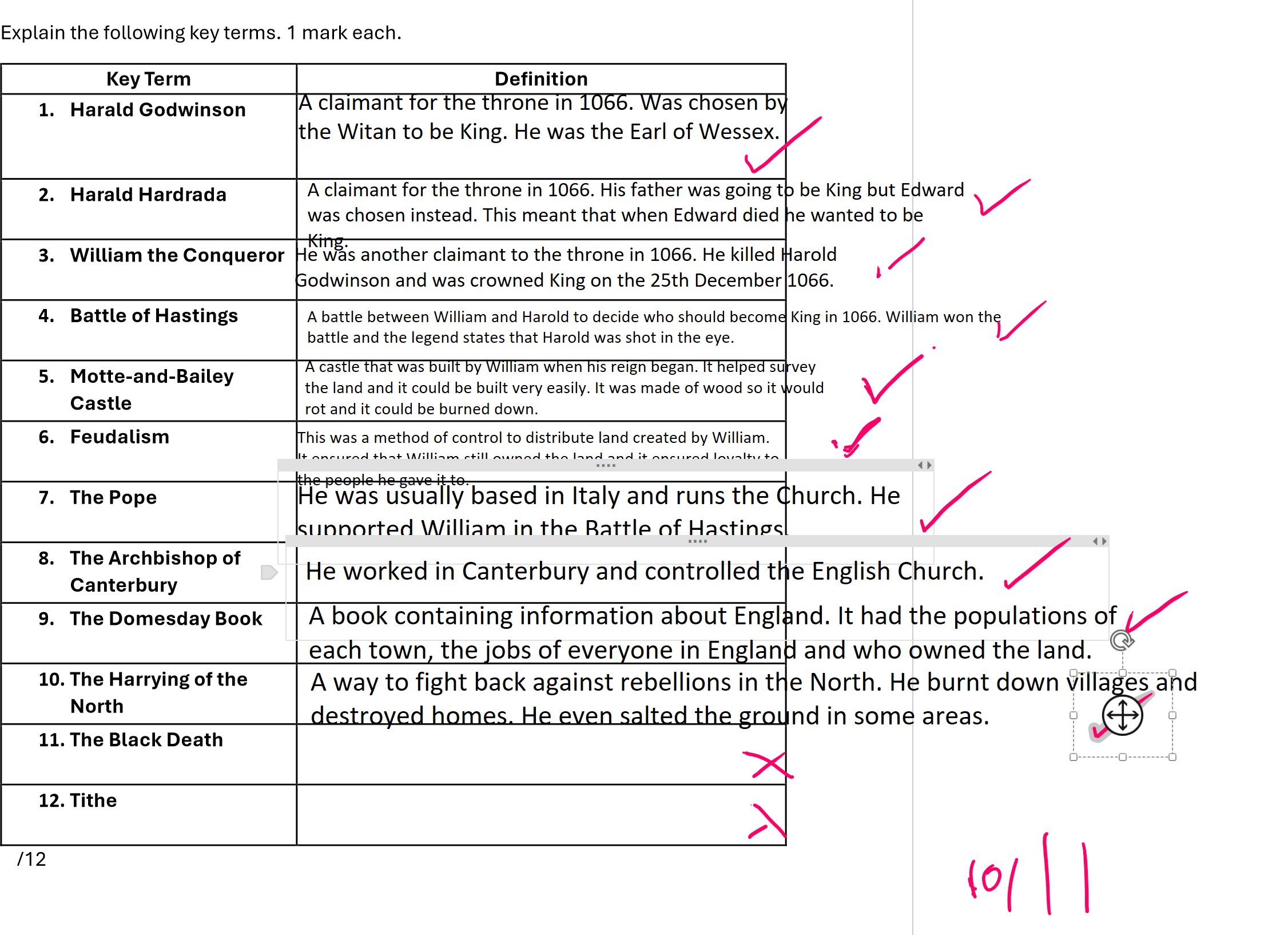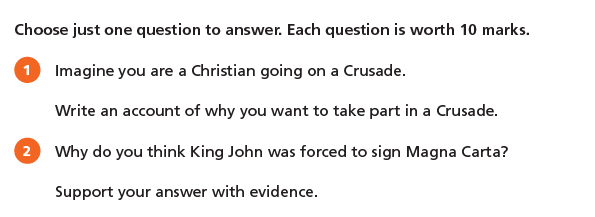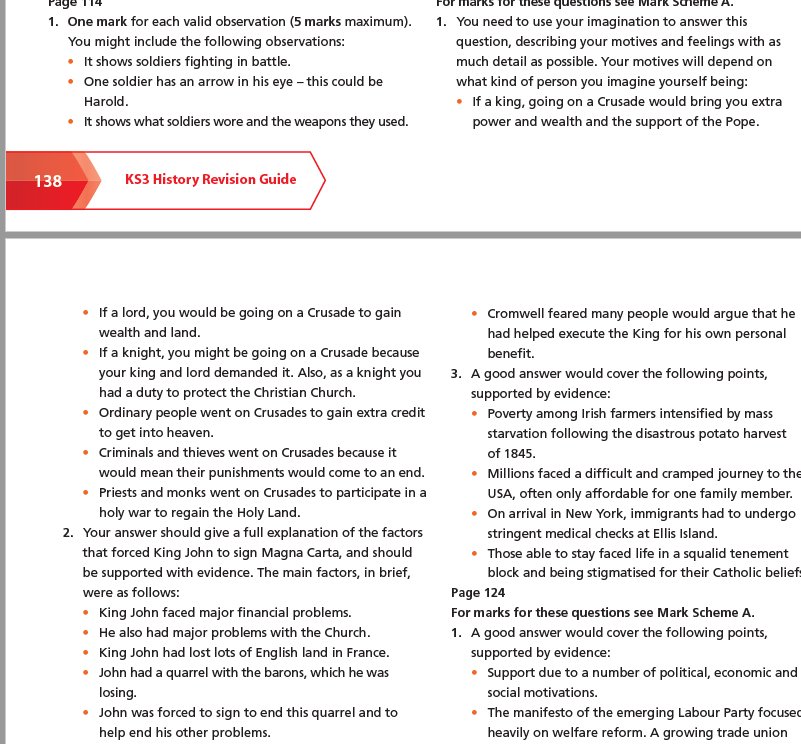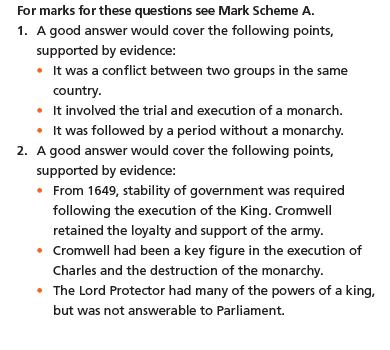Medieval England
1/81
There's no tags or description
Looks like no tags are added yet.
Name | Mastery | Learn | Test | Matching | Spaced |
|---|
No study sessions yet.
82 Terms
What years were the medieval period in England?
1066–1509
Which king died without an heir, leaving claimants to fight?
Edward the Confessor
Who were the three main claimants to the throne?
William: had the Pope’s support, said Edward had promised him
Harold Godwinson: Earl of Wessex, the Witan chose him.
Harald Hardrada
Who won the Battle of Hastings?
William the Coqueror. This was the start of Norman Rule in England.
How did William win the Battle of Hastings?
William invaded England by crossing the Channel from Normandy
At the same time Harald Hardrada, King of Norway and Denmark, invaded northern England from Denmark.
The Saxon English king, Harold, marched his army to the north of England to fight Harald Hardrada first.
Harold defeated the Danes at Stamford Bridge in Yorkshire and then marched all the way south to fight William near Hastings.
At the Battle of Hastings the Saxons fought well but their king, Harold, was killed.
William of Normandy won the battle, marched on towards London and on 25 December 1066, he was crowned King William I.
What is name of the cloth that depicts scenes from the Battle of Hastings?
A description of the battle was embroidered on cloth. It is called the Bayeux Tapestry, after the town in Normandy where it was made. The tapestry shows the main events of William’s invasion of England and the Battle of Hastings. It was made over a decade after the battle.
Name three things William did to exert control after winning the Battle of Hastings.
Feudal system. 2. Castles (motte and bailey) 3. Domesday Book
What is the name of the system of organising society that was introduced by the Normans?
Under the feudal system King William I owned all the land in England. The King kept one-quarter of the land for his own use and gave the rest to his main supporters, barons and bishops.
About 200 barons and bishops controlled three-quarters of England’s land. They gave land to about 400 knights, who gave service to their barons in times of war. Most of the work in England was done by 1.5 million peasants.
They were allowed small plots of land. In return they had to work for the baron when required.
The feudal system meant that power in England was centred on the King and his barons and bishops. Most Saxons lost their land.
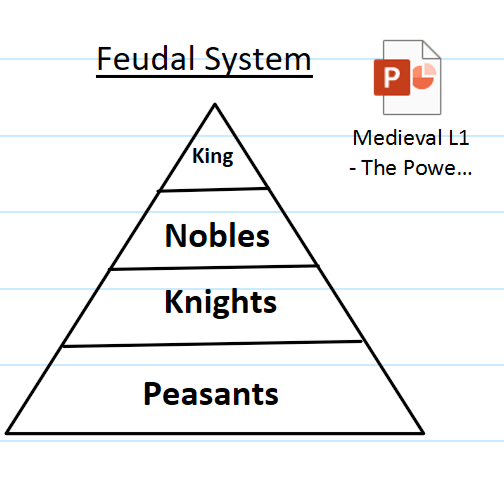
What is another name for peasants in the feudal system?
These peasants were called villeins.
What was the Domesday Book?
In the winter of 1085–86 William I did something extraordinary that had never been done before. He made a survey of all the land in England and recorded it in a book, the Domesday Book. It was important because he did not know England at all.
William sent officials around the country to ask questions about who owned land and what the land was worth.
The Domesday Book mentions all of England’s villages and records the value of their land. This gave William information about the wealth of his kingdom. It also showed the wealth of each of his lords and bishops.
This was important because it showed William how much tax he could claim from each lord and bishop.
In medival England, religion was super important to people. Why?
The vast majority of people were illiterate and looked to religion as a way to organise their lives.
The fear of death was felt by everyone in a time when there was only basic medical knowledge and for most people life was nasty, brutish and short.
Virtually everyone in England at this time were Christians.
In England, the head of the country is the King. There was a separate organisation for the Christian church. Who was the heas of the Christian Church in medieval times?
The Head of the Western Church was the Pope, in Rome, Italy. He was God’s representative on Earth.
The Pope was chosen by senior churchmen called cardinals.
Who was the most senior churchman in England?
In England the most senior churchman was the Archbishop of Canterbury. Below him were bishops who organised the Church across England in areas known as dioceses.
Within each diocese were hundreds of parishes, each led by a parish priest who performed religious services in a church.
There were also monasteries and convents where religious people worked and prayed. These were led by abbots and abbesses. Monks lived in monateries.

Why was the Church so powerful?
The Christian Church owned large amounts of land
The church helped to spread news about events throughout England and its information was used in schools. They were today’s mass media.
Life was unpredictable, with a constant fear of disease and death, but many believed that the Church offered a route to everlasting life in heaven. Even the King and lords looked to the Church to help them get to heaven.
The church also had power over the King. They would hand over pieces of their land to have monks (called chroniclers) write good things about them. The archbishop would also be placed as a temporary King if the main King had to leave.
One of the Pope’s greatest powers was his ability to excommunicate people, even kings. Excommunicants were no longer members of the Church, and it was believed that when they died they would go to hell, a place ruled by the Devil.
Many English kings and lords at this time were illiterate, like the vast majority of the population. The Church was home to priests and monks who could read and write. They were employed by the King and lords to help them administer their lands.
What are indulgences?
The church also gained lots of money from corrupt payments called indulgences. If someone paid this, they would be forgiven of their sins.
What are ‘Doom Paintings’?
The 'Doom paintings' were created to scare people about what hell was like and to force them to listen to the church.

What is a pilgrimmage?
One of the only ways ordinary people could leave their town or village would be by going on a pilgrimage.
A pilgrimage is a journey to a religious place, usually associatedwith a holy person whose remains or relics could be seen.
Pilgrimages were regarded as a help in the quest for heaven.
The King and the Church worked well together, supporting each other. But in the late 1100’s (Twelfth Century), under Henry II, that changed. What happened?
A conflict developed between King Henry II and the Archbishop of Canterbury, Thomas Becket. Becket had once been Henry’s chief minister.
When he became archbishop, Becket wanted the Church to be separate from the King, in particular in courts of law. Becket supported separate Church Courts for priests and monks. Henry wanted the clergy to be tried in the same courts as ordinary people to ensure fairness.
In 1170, some knights murdered Becket in Canterbury Cathedral. They thought they were acting for the King, but there was outrage. Henry II felt very guilty and volunteered to be punished – he was flogged in public.
Becket was made a saint, or holy man of the Church, and Canterbury became a place of pilgrimage.
What were the Crusades?
The Crusades were a series of wars between Christians and Muslims over control of the Holy Land, modern-day Israel.
The main goal of the Crusades was to capture Jerusalem, thecity where Jesus was crucified. This is an important city for Muslims, Christians and Jews.
How long did the Crusades last?
The Crusades began in the late 11th century and lasted almost 200 years.
Why did the Pope want the Crusades?
Pope Urban II hoped it would make the Church more powerful.
Why would people want to go on a Crusade?
People went on Crusades for many reasons:
– Some kings and lords were seeking money and power.
– Others believed it would get them into heaven when they
died.
– Criminals and thieves went to escape punishment.
— Freedom and adventure; to see the world
— To gain land
— Serfs went because the Pope promised their freedom if they went

Say what event happened in what Crusade.
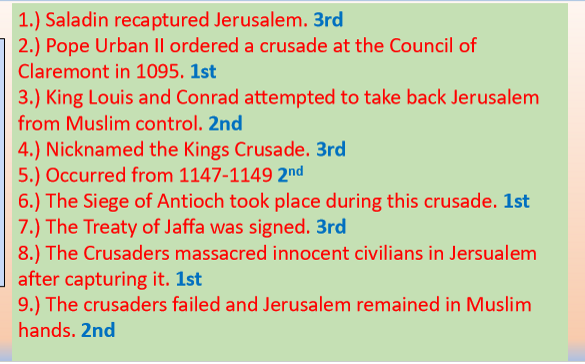
What route did the Crusades take and why?
The Crusaders travelled through many countries, including France, Germany, Italy and Romania. The Crusaders chose this route because these countries supported them and were allies with them. This ensured their journeys could be completed safely and they would only have to battle when they reached their destination.
What happened in the First Crusade? 1096-99
Ordered by Pope urban II to take over Holy Land
Crusaders faced terrible conditions and harsh weather
They had to walk the whole way and lots of them died of plague or starvation
After finally reaching Jerusalem they mercilessly murdered everybody in the country
What were some key events of the Second Crusade? 1147-49
Crusader States were made to rule the newly conquered land
Many crusaders went back home
Crusaders protected their land with castles but Muslim wanted their holy land back, and started a holy war
This Crusade was led by King Louis VII of France and King Conrad III of Germany
They suffered a defeat, ending the Second Crusade. Muslims won.
What are some key events of the Third Crusade? 1189-92
It was called the King’s Crusade because it was led by Kings, including Richard I (Richard the Lionheart). Jerusalem had been captured by Saladin, a major muslim warrior king and the ruler of Egypt and Syria. Pope Gregory ordered a Crusade to recapture the city. Ended in a truce called the Treaty of Jaffa. Muslims still ruled Jerusalem, but Christians were allowed to visit.

What difficulties would the Crusaders encounter along their journeys?
They might have had many difficulties on the crusades, especially the first and seconds ones as they walked the journey. Supplies were poorly organised and they were not used to the heat. In further crusades, other issues may have occurred such as boats being lost in storms.
What were some miltary orders (units of knights) involved in the Crusades?
The Knights Templar (managed finances). Knights Hospitaller (cared for injured and sick pilgrims). Teutonic Knights (set up hospitals).
What were some lasting impacts of the Crusades?
The Crusades had an impact on many areas including trade, finance, architecture and science.
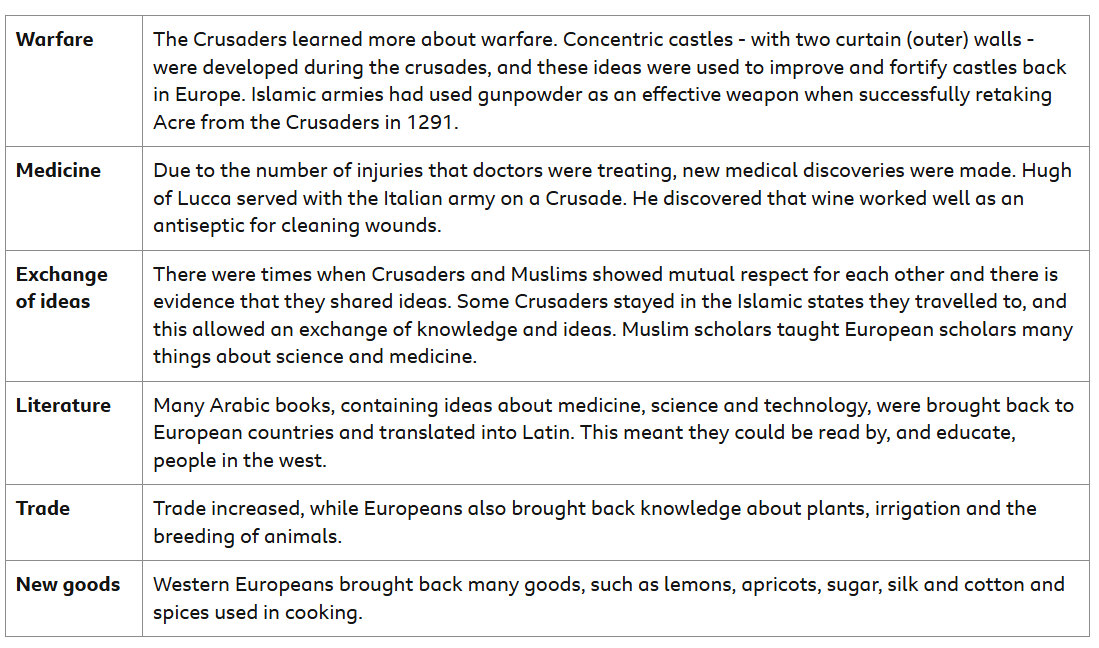
Who ruled England after Richard I (Richard the Lionheart)?
King John came to power in 1199 after his brother Richard was killed in France.
King John started his reign with a lot of problems. Why?
Richard I had left England in a great deal of debt due to wars with France and the Third Crusade.
Richard I had been a great warrior king while John was regarded as weak. His nickname was ‘John soft sword’.
When he became King of England, John had problems controlling his lands in Wales and Ireland.
John also faced attacks from Scotland, which was anindependent country.
During most of his reign England was at war with France.
By 1204, John had lost most of England’s territories in France,
such as Normandy.
John also had problems with the Church. Why?
In 1205, the Pope appointed Stephen Langton as Archbishop of Canterbury, the most senior position in the English Church.
John disliked Stephen Langton and wanted his own choice of archbishop.
In 1205, the Pope, Innocent III, stopped all religious ceremonies such as marriages and burials in England. This lasted for seven years.
John, in return, took money from the Church and expelled monks from England.
In 1209, the Pope excommunicated John, which meant John was no longer a member of Church.
This quarrel seriously weakened John’s position as king.
John also had problems with the barons! Why?
Barons expected their king to be a good warrior and to involve them in running the country. John was a poor warrior who tried to rule on his own.
He also gave top jobs in his government to foreigners rather than barons.
John’s wars with France, Scotland, Wales and Ireland were very costly and the King expected the barons to pay extra taxes to fund them.
Was John a bad king?
Some historians would argue that King John was not as bad as people have made out. John was a very good organiser and manager. He was very intelligent and good at planning military tactics. However, most historians would say he was not a good king, as he spent most of his time fighting wars, barons and the church.
What does ‘Magna Carta’ mean in Latin?
It means ‘Great Charter’. Latin was the commn language used in England at the time.
When and where was the Magna Carta signed?
Magna Carta was a charter signed in 1215 at Runnymede, an
island in the River Thames, west of London.
What was the Magna Carta?
The charter was an agreement between King John and the most senior landowners in England, the barons.
The agreement limited the powers of the English King and protected the rights of the barons.
It also gave Englishmen certain important civil rights such as trial by a jury of fellow Englishmen.
It is regarded as one of the most important documents in
English history and helped lead to the creation of the national parliament we have today.
Why did John sign the Magna Carta?
By 1215, John had fallen out with the barons and the Church and had been defeated in war by France. Unhappy with the extra taxes they had to pay for the war, the Barons revolted and formed their own army. In May 1215, the barons captured London. They forced King John to sign the agreement. He signed hoping it would end the barons’ revolt.
What changes did the Magna Carta make?
The King would not interfere with the Church.
When a baron inherited land he should not pay more than £100 to the King.
The King could not raise any new taxes without the agreement of the barons and bishops.
Freemen could not be put in prison without a trial by a jury offreemen.
The King’s judges had to be fair to everyone.
Everyone was free to enter or leave England. They did not need the King’s permission.
Why was the Magna Carta important?
Magna Carta was the first time an English King had agreed to protect the rights of Englishmen in writing.
It was important because the King no longer ruled without thesupport of the barons and the Church.
It gave freemen (people who are not villeins) in England certain rights.
However: Most Englishmen were not freemen but villeins, so were unaffected by Magna Carta.
When was the first Parliament created?
Under John’s son, King Henry III, England’s first Parliament was called in 1265 by Simon de Montfort.
This Parliament contained barons, bishops, two knights from each county and town representatives.
Barons and bishops formed the House of Lords.
Knights and townspeople formed the House of Commons. The members of the House of Commons were elected.
These changes laid the foundations of the Houses of Parliamentwe have today.
What was the Black Death?
The Black Death was a severe outbreak of disease that affected England from 1348 to 1350. It is also called Bubonic Plague, and was spread by fleas on black rats.
Where did it originate, and how did it get to England?
The disease orginated in the Middle East and was brought to England by black rats on boats from Europe.
It spread from ports all over the country within a year and hada devastating effect on England.
How many people did it kill?
The Black Death killed about one-third of the population.
In England, 7 500 people a day died of the Black Death.
Everyone was affected – old and young, rich and poor.
How did people believe it was spread?
Many people thought the disease was a punishment from God and therefore felt that if they prayed a lot it would save them. Others whipped themselves as a form of punishment to please God.
A popular idea was that the end of the world was coming. Venus, Mars and Jupiter were all seen together in the sky in1348, making people think a disaster was going to happen.
A popular belief was that the disease was spread by ‘bad air’.
How did people try to cure the Black Death?
One method of dealing with the disease was to seat victims near a large fire, which would destroy the bad air.
• Other people, including plague doctors, placed sweet-smelling dried flowers and herbs over their nose and mouth to prevent the bad air from entering their body.
• Others used dried toads and leeches as a way of removing the poison from diseased bodies.
• People put figs and butter on the swollen lumps to soften them.
What were some symptoms of the disease?
To begin with victims suffered from flu symptoms of sweating and coughing.
Then large lumps appeared on their bodies, usually on the arms and legs.
These lumps, or buboes, were first red in colour, full of blood, but then turned black, giving the disease its name. Lumps went black as blood in the body dried out.
Victims suffered high temperatures.
Blotches appeared all over the body.
Most people who caught the Black Death died within five days.
What were some social effects of the disease?
Whole villages and towns were wiped out by the Black Death.
The population of England dropped by about one-third in two years because of the disease.
People began leaving towns and going to live in the countryside in an attempt to avoid it.
Foreigners and non-Christians, such as Jews, were attacked because some people blamed them for causing the disease.
Jews were forced to live in separate parts of towns and others were banned altogether.
What were some economic effects of the disease?
With fewer peasants much agricultural land was unused.
Peasants left their fields and unattended livestock were left to die.
Food supplies started to run low and prices rose.
As there were fewer peasants to work the land and fewer craftsmen in towns these people began to demand higher wages.
Villeins began to refuse to work on the lord’s land for free. They disliked this obligation and resented having to pay taxes.
Lords offered villeins more food and money to work their land, so those who survived benefited from the changes brought by the Black Death.
How did the Black Death weaken the Church’s influence?
Many people began to lose faith in the Christian Church.
They had been told that the Black Death was a punishment from God but churchmen and those who prayed also died.
There were fewer people to provide religious help as 40 percent of priests and monks had died in the Black Death.
Richard II came to power in what year?
Richard II became King in 1377. He was only 10 years old in 1377 so England was ruled by his advisers.
Following the Black Death, when one-third of the population died, England was short of wealth.
Richard had inherited a very costly war against the French, called The Hundred Years War.
Life for peasants in medieval times was very unpleasant. What is a serf? What is a freeman?
A serf is a peasant who is tied to the land they work on. A freeman was not tied to a lord and could travel more freely and acquire more wealth.
What is a tithe?
A tithe is a payment to the church, which is 10 percent of what the farmer produced in a year. It could be paid in seeds, cash or equipment.
What were peasants’ houses made out of?
Wattle and daub, with a thatched roof and no windows. It would have been very smoky inside.
How was law enforced?

What was the Peasants’ Revolt in 1381?
The Peasants’ Revolt in 1381 was the most serious rebellion in the Middle Ages.
There were many reasons for the revolt including the introduction of Poll Tax and peasants wanting fairer rights.
It started in Fobbing in Essex, and was centred on counties close to London, most notably Essex and Kent.
To end the revolt Richard made many promises to the rebels, which he subsequently failed to keep.
Although the King and lords triumphed, the shortage of labour after the Black Death meant that peasants’ wages actually rose.
Tell me about the Poll Tax, the immediate cause of the revolt.
-Poll Tax was a tax paid by all adult men.
– The tax was needed to pay for the ongoing war against
France (the Hundred Years War).
– Everyone, rich and poor, was charged the same amount of
tax: five pence per person in England.
– Peasants feared new taxes after the introduction of Poll Tax.
What are the main events of the Peasants’ Revolt?
In May 1381, a tax collector arrived in Fobbing to find out why people weren’t paying their poll tax. He was thrown out.
That same month, in Kent, peasants sezied a castle. They recognised Wat Tyler as their leader.
Essex and Kentish groups organised themselved into armed groups and marched into London. They attacked the homes of the King’s advisors. Some rebels murdered the Bishop of London and the Royal Treasurer. They also murdered the organiser of the Poll Tax.
At Smithfield in a short scuffle Tyler lashed out at the King but the Mayor of London killed Tyler with his sword.
In total, there were about 50,000-60,000 peasants involved.
What did King Richard II do to try to appease them?
On 14 June, Richard II met the Essex rebels at Mile End.
– Richard II promised to free any rebels from prison, pardon them and punish his advisers.
Did Richard keep his promises?
Richard II agreed to all the rebels’ demands. They returned to their homes thinking they had won.
Apart from putting an end to the Poll Tax, Richard II went on to break all the promises he had made.
Why did the revolt fail?
– The rebels lacked discipline and organisation.
– Most of the rebels accepted Richard II’s promises and therefore returned home.
– Richard had many rebel leaders hanged.
– In Essex and Kent, 8 000 royal troops restored order, killing 1,500 rebels.
– The King claimed all his promises were made under threat, so did not count.
– The rebellion was based mainly in Essex and Kent, not across the whole country.
Did the revolt change anything? How did life change after?
The Poll Tax was withdrawn.
The shortage of labour caused by the Black Death eventually forced lords to pay peasants wages.
The feudal system, which had been introduced by the Normans,began to collapse.
Richard II, although only 14 years of age, showed great calm during the revolt and won admiration.
Charles I became King in 1625. There were many causes of the English Civil War between 1642 and 1648, but most of them had to do with religion, power and money. Give some religious reasons.
Charles I was married to a French Roman Catholic.
One of Charles’s advisers introduced unpopular ideas such as burning incense and candles during church services. These were seen as Catholic practices at a time when England was Protestant.
In 1637, Charles tried to enforce a new prayer book in Scotland.
Most Members of Parliament were Puritan (strict Protestants), and disapproved of Charles’s Catholic connections.
Give me some reasons to do with power.
Charles was often seen as arrogant. He strongly believed in the ‘Divine Right of Kings’, which meant God had chosen him to be King and no one could question that choice.
Charles ruled without Parliament between 1629 and 1640. This is known as the ‘eleven years of tyranny’.
Charles used the private Court to ruthlessly punish his opponents, and fine people when he was short of money.
In 1642, Charles attempted to arrest five Members of Parliament, including Oliver Cromwell, on a charge of treason when they refused to give in to his demands.
Give me some reasons to do with money.
Charles was known for his extravagant, expensive lifestyle, which often left him needing more money.
In 1635, he extended Ship Tax, previously only paid in coastal areas, to the whole country.
He fought two expensive and unsuccessful wars, with Spain in 1625 and France in 1627.
What were the two sides called in the English Civil War?
The English Civil War was fought by the Royalists (Cavaliers) and Parliamentarians (Roundheads).
Who were the Cavaliers?
• The Cavaliers were:
– supported by most of the gentry
– often from northern and western regions, with some Irish,
Scottish and Welsh soldiers
– had the better horsemen, or cavalry, which is where they get
their name Cavaliers
– generally conservative Protestant or Catholic
– mainly led by Charles’s nephew, Prince Rupert.
Who were the Roundheads?
• The Roundheads were:
– mainly merchants and traders
– generally from London and the south-east
– in control of London and the navy, increasing their power
– mainly Puritan, a strict Protestant movement
– latterly led by Oliver Cromwell, who proved himself a key solider.
-- Names after their much shorter haircuts than Cavaliers’ long wigs
Who won the English Civil War?
The Roundheads. Oliver Cromwell developed ‘New Model Army’, meaning soldiers were to be trained in peace time as well as war. At the Battle of Naseby, Cromwell won a decisive victory.
What was the Second English Civil War?
This was when Charles, after fleeing from Hampton Court Palace where he was being held as a prisoner, sided with the Scots and raised another army that invaded England. They lost and Charles was eventually recaptured.
Why was there so much uncertainty around what to do with King Charles?
Many MPs did not want the King to stand trial. Charles was the first monach to ever be put on trial.
Cromwell only allowed MPs into Parliament if he believed they wanted the King to stand trial. This was known as the ‘RumpParliament’.
He was accused of being a ‘tyrant, traitor and murderer’.
Charles was found guilty: true or false.
True.He was found guilty of all charges and sentenced to be executed on 30 January 1649.
Cromwell’s signature can be clearly seen on Charles’s death warrant. He is widely rumoured to have been a key supporter in the decision to kill the King. He was one of 59 MPs to sign the death warrant.
Where was Charles executed, and why was it delayed?
Charles was executed on scaffolding erected outside the Banqueting Hall in London.
His execution was delayed as the executioner scheduled to carry out the beheading refused to do it. It was a struggle to find anyone willing to kill the King.
Charles allegedly wore two shirts as it was a cold day. He did not want to shiver and lead the crowd to believe he was afraid.
Spectators dipped their handkerchiefs into his blood following the execution owing to the belief that the King’s blood had healing powers.
Who ruled England after Charles?
Following the defeat of King Charles I in the English Civil Wars, and later his trial and execution, Oliver Cromwell became ‘Lord Protector’ in 1653.
Cromwell was a Puritan, a strict Protestant, and made significant changes based on his beliefs.
He had led the Roundheads in the Civil War
Who were the Puritans?
They believed that the Bible should be read and studied closely, and that people should spend more time praying and thinking about God. Cromwell wore plain, black clothes and introduced laws to ban popular pastimes, such as bear-baiting, celebrating Christmas and going to the theatre. Puritans believed that entertainment might distract people from their religious duties.
Cromwell was offered the position of King. True of False?
True, however he turned it down, as he was a Republican and abolished the monarchy. He said he could not accept a role he had spent so long fighting against. Despite not taking the title of king, Cromwell had many similar powers. He was not elected into his position, largely made decisions on his own and was replaced by his son.
True or false: after Cromwell, England once again returned to the monarchy.
True. Charles II was greeted with huge enthusiasm on his return to the country. Many people had disliked Cromwell’s harsh rule.
